using APPS
SALES &
CUSTOMERS

Business Central expert
This is #2 of 8 articles about how to cover your entire business with BUSINESS CENTRAL
– without customer extensions
– only using APPS
Fulfill all your needs for managing SALES and CUSTOMERS in BUSINESS CENTRAL.
In this article, we explain what you should require, how you avoid customizations, and which APPS to use.
Sales are basically about having a dialogue with customers and business partners, where we offer goods and services – and match the customer’s expectations with our ability to deliver.
After that, we receive an order, and it can come in via many different order channels. We then confirm the order to the customer, and when it comes to delivery, we plan the delivery, which often also involves the sales department, and which must at least match what we have promised in the sales process.
These are basically the sales processes that Business Central must manage.
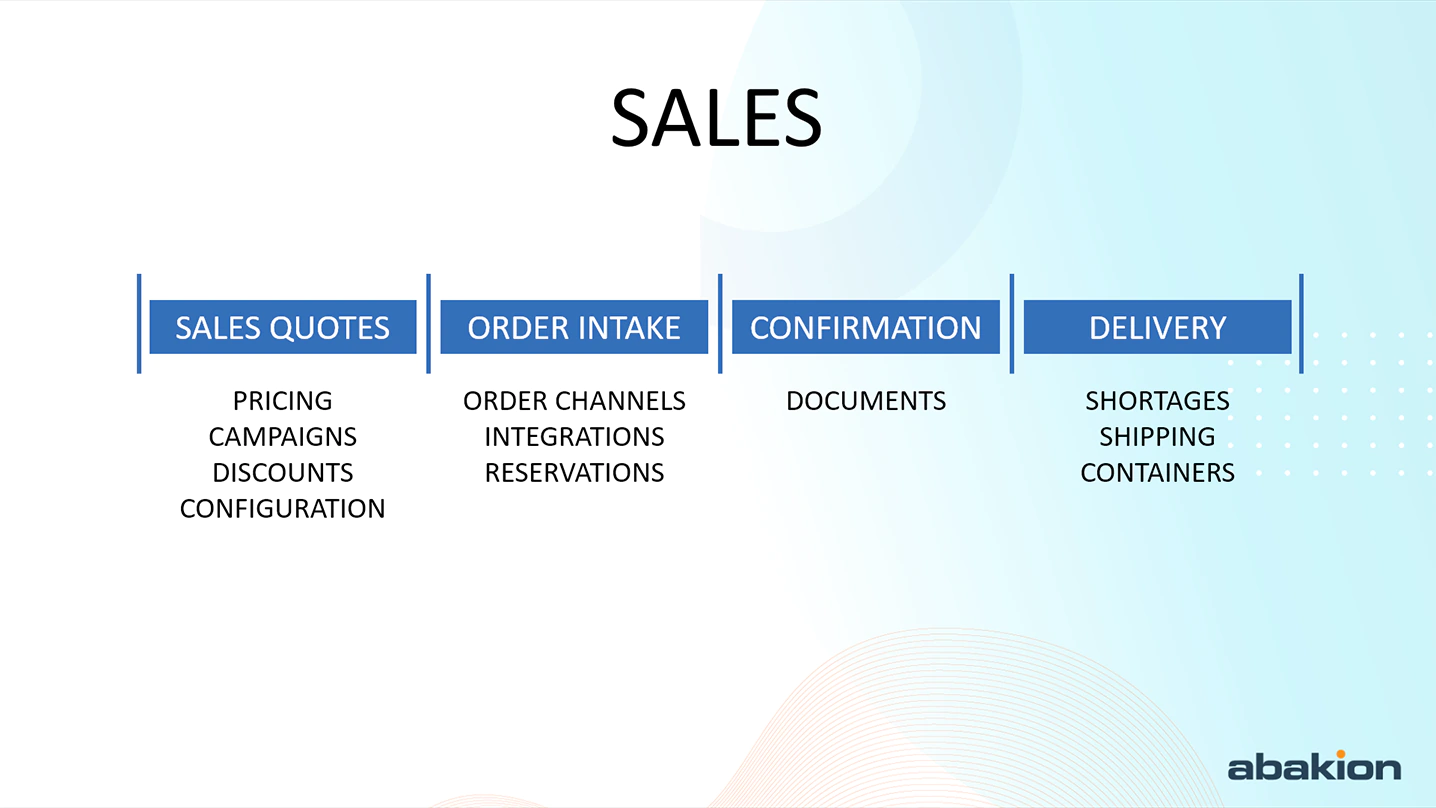
Pricing and Quotes
It can be a complex task to calculate prices for customers in Business Central. Campaign discounts and pricing agreements can take many forms, and we must be able to manage it all in Business Central.
There are volume discounts and campaign discounts, and then there are custom pricing agreements for individual customers. Valid only for a limited time. Specific for a location. Or for a selected assortment. It can be very complex to calculate an exact price automatically.
If we want to produce a quote quickly, then we must have our prices structured and up-to-date. Business Central is quite good at this without needing add-on solutions.
But it may be that the item must be configured according to the customer’s wishes. This is typically also a challenge in Business Central.
» Sales Configuration

Subscription
If we sell subscriptions, then this is a separate management need. We need an easy way to produce subscription-based invoices – in bulk for a selected renewal date.

Rental
And if we have rental items, this also requires a dedicated solution. We want to be able to rent items to customers on a regular Sales Order, and draw on all the Business Central functionality for planning, availability, reservations, warehouse management with locations, serial numbers etc.

Communication
We manage the communication and the relationship with the customer in a CRM-system, because that’s what it’s good for.
CRM is good for managing relationships. We can keep a journal of the dialogue. While ERP is good for transactions and everything about numbers and money. The inside sales and the sales assistant will probably like to type in ERP because they are interested in quantities and money, but the salespeople would rather use CRM because they are interested in the relationships and the dialogues.
» CRM & Marketing
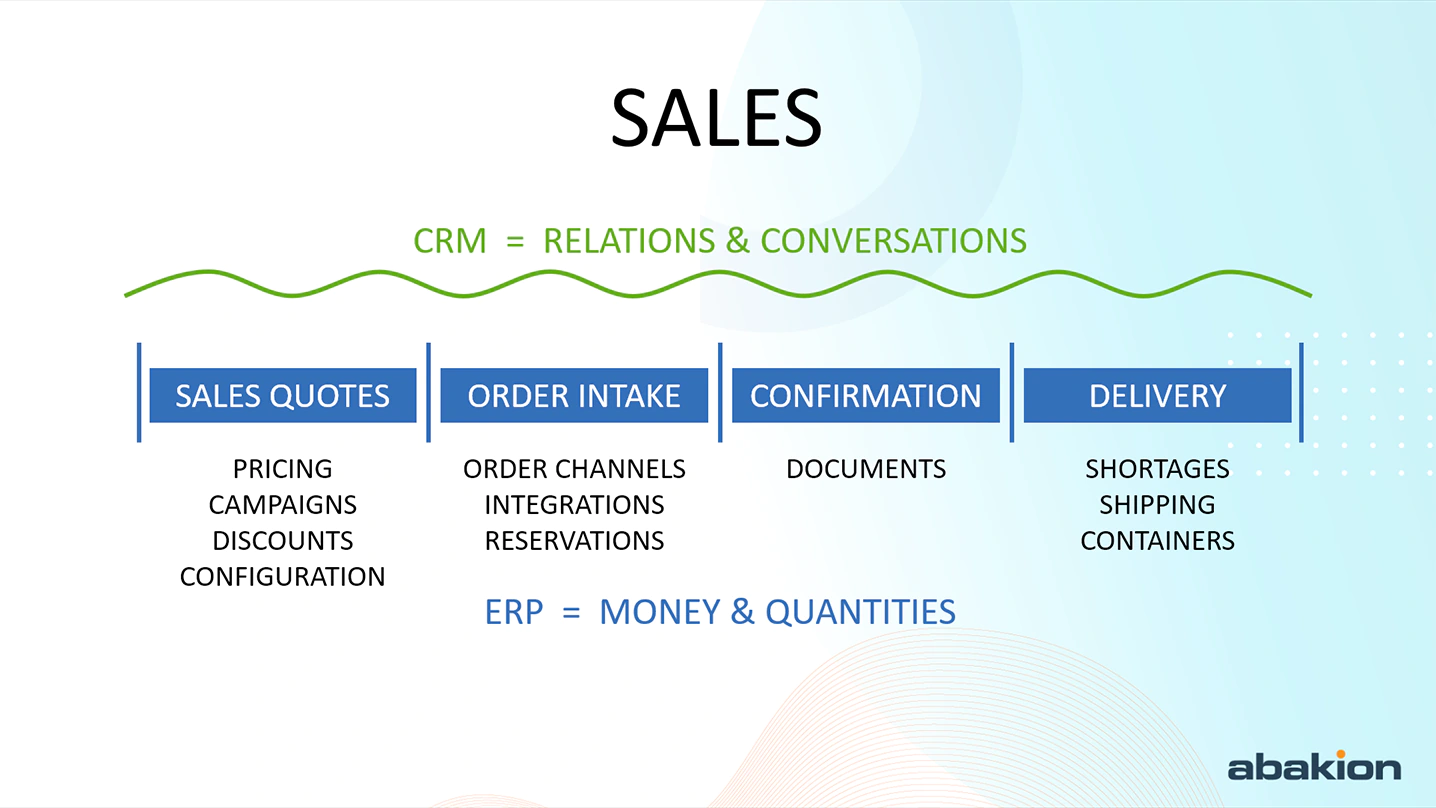
Order taking
The order can be received in Business Central via many different channels. These are, for example, field sales, inside sales, orders by email, point-of-sale, etc.
We may have an e-commerce store, or a partner portal where franchisees, distributors or other resellers can place orders. We may also have EDI agreements with selected customers. And then we have to be ready for all the new order channels that appear – this could be, for example, chatbots, social media commerce, in-app purchase, etc.
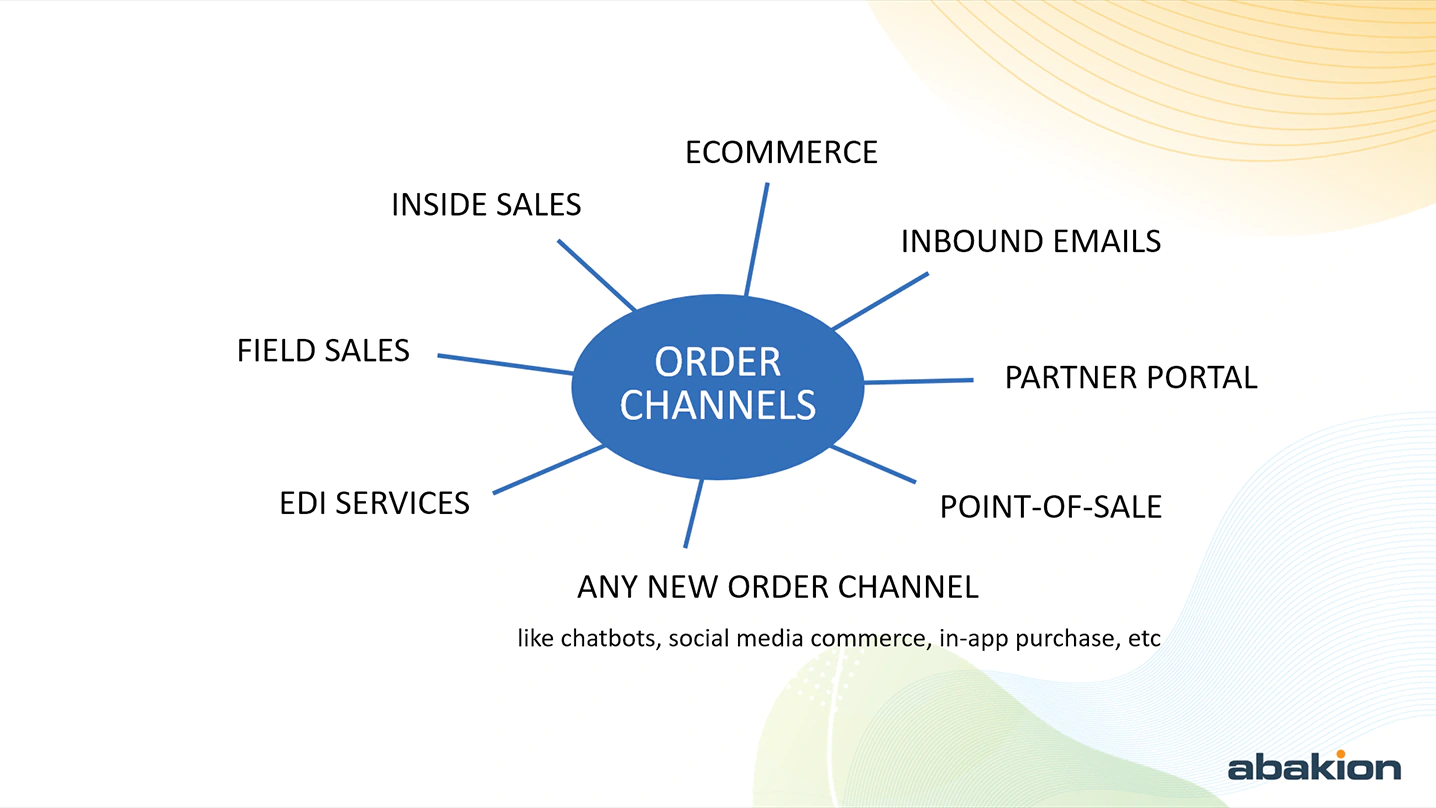
We use the following apps to receive orders in Business Central – some apps are for specific purposes, and Commerce Manager is the multi-tool that allows us to add new order channels easily.
Integrations are a big topic in order entry. Integration is not something that is particularly interesting for those who want to optimize sales processes, but it is an important prerequisite for making all the company’s order channels work in an automated way.


Reservation and allocation
When we take the sales order, we must be able to reserve the item in the warehouse in a smart way. We must prioritize sales orders and allocate items in stock in the best possible way.
We have an item in stock now, but there are only a few left. The remaining quantity is reserved for a sales order to be delivered in one month.
However, we will receive a whole container full of the product next week. If there is a customer who would like to place an order for delivery now, then Business Central will reject the order because the current inventory is reserved. But we want to handle reservations smarter. After all, we get plenty items delivered in good time, so we can release the current stock to another customer. It is important that we can carry out this type of prioritization.
» Reservations and Allocations in details

Confirmation
When we send a confirmation of the order to the customer, and when we later send a delivery note and an invoice, the layout of these documents is an important topic in Business Central.
The documents must contain certain information and master data, and they may need to be in a different layout for certain customers. We must also be able to send documents by e-mail or EDI. We solve this with the following two apps:


If we have many companies that trade with each other, then we also have to keep track of intercompany.
We must be able to look up how many are in stock in other companies, and have the item sent directly to the customer. And we won’t spend time posting the transactions.

Delivery
Delivery planning and execution do not involve the sales department very much, but if a shortage occurs on a sales order, then we must be able to handle it, and the seller may be involved again to provide good customer service and resolve the conflict.
For this task, we need tools to resolve shortage conflicts in the best way, clarify exactly what is possible to deliver when – and to provide delivery dates we can trust.


Sales may also be involved in planning deliveries to the customer. We require a simple way to book a shipment with a freight forwarder and print a waybill. And for larger shipments, we must be able to plan the shipment of a container, pack it in an efficient way, and get it shipped without too much to manual registration work.


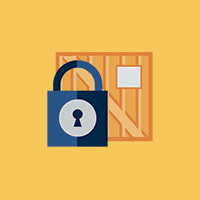
RESERVATIONS AND ALLOCATIONS
The standard in most ERP systems is that you can create reservations as ‘hard reservations’.
This means that, if you have the item in stock, or have a purchase order on the way or a production order that the items are to be produced on, then you can point at the relevant receipt from the sales order, and reserve it for the demand.
There are many companies that make use of this feature.
Unfortunately, this locks up a lot of things in the ERP system because, once you have made the reservation, it is set ‘hard’. This means that, if you want to revise your plans because the demand dates have changed, you must “break” the reservation manually.
The trouble is that sales orders do not always arrive in chronological order of required delivery, or that you prioritize customers differently.
If you receive an order that must be delivered in 3 weeks, and you reserve the item from inventory, and then tomorrow you receive a rush order that must be delivered in 3 days, you may not be able to deliver.
You don’t have time to purchase the item, because the lead time is 1 week. However, it is obvious that you could just break the reservation, use the item in stock to deliver the rush order, and then order new items for the order to be delivered in 3 weeks.
It is quite logical – but it must be done purely manually if we use hard reservations.
And the question is: will we ever realize that the issue can be resolved by breaking a reservation? Because most systems will just tell us that we cannot supply the rush order.
Soft reservations
This is what makes the idea of ‘soft’ reservations in the ERP system interesting. For many companies, ‘soft’ reservations are the key to raising the service level.
Most companies need a smarter way of managing reservations, one where the system can calculate what is feasible on the principle of ‘first come, first served’.
When we add an item to a sales order line, the ERP system should calculate what is feasible; unless we receive a notification, we should be able to assume that it is deliverable.
The ERP system should help us work out the mathematically most intelligent allocations. This is what we mean by ‘soft’ reservations.
Reservations and Warehouse Management
Reservations are even more difficult if we are also running a Warehouse Management system. It requires us to take lot numbers and bins into account.
If we have placed the same item in different bins in the warehouse, because they have been put away in multiple operations, a reservation will typically relate to a specific bin and lot number.
The system forces the picker to pick from a specific lot number and bin, which can lead to some quite inappropriate processes in the warehouse, perhaps a pallet being broken unnecessarily or a possibly suboptimal picking route being created.
With Warehouse Management, there is added complexity in the management of reservations.
Reservations and Sales Orders
Let’s say, we have a customer on the phone who wants to order 100 of an item for delivery in 2 weeks. We add it to the sales order line and find that it unfortunately cannot be delivered.
We tell the customer that he can have a partial delivery of 80 units in 14 days, but, if he can accept delivery in 18 days, then he can have all 100 units in 1 shipment.
Being able to have this conversation with the customer while still at the ordering stage is brilliant. All expectations have been agreed from the outset.
We want Business Central to be able to give us this information – immediately as we add items to sales order lines, not after a batch job has completed during the night.

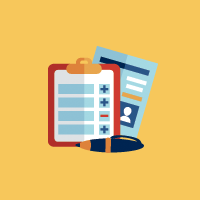
SALES CONFIGURATION
Configuration is essentially about managing the ways in which configurable products can be put together according to customers’ wishes.
These may be relatively low-complexity products, but with some variables that the customer can choose. The challenge is that this can quickly result in thousands or millions of possible combinations, which we do not want to create as separate item numbers in Business Central.
Configuration has gradually entered many different industries, whether it is buying a car, a bed, a wood-burning stove, or something else.
There are two things we want to achieve with configuration, and in practice there is a difficult trade-off between these goals:
- We want to create a good customer experience where the customer is guided through the options;
- We want easy management of the configurations in the ERP system, so we don’t drown in item numbers and bills of material.
This is difficult to achieve in ERP. There are some add-ons that support configuration, and you should choose one of them if you need configuration, because it is a lot of work to build your own.
Logical, valid choices
It must be easy for the customer to make the right choices when configuring the item, and naturally the ERP system must ensure that the customer makes only valid selections that we can actually deliver.
All the dependencies between options must be configured in the ERP system. And it would be great if the configurator could show as the customer goes along what effect each choice has on price and delivery.
No fixed order
The experience must be user-friendly, and the customer should not be forced to make decisions in a particular order.
The ERP system must support decisions being made in an arbitrary order. This creates certain challenges managing the dependencies between selections – and the ERP system must handle this structure proficiently.
Sequence and indecision
Choices may also mean that there are no longer any decisions to be made on some of the subsequent questions, and the configurator should not ask about them. It should also be okay if the customer has no preferences regarding some questions. The configurator should not force the customer’s hand.
The sequence of questions, rules on what must be answered first – these things have a big impact on the user experience on the website or with the order-takers.
Avoid creating items
Some configurators can only produce a configured item by creating it as an item in the ERP system. This means that, once the customer has put together his item, it is created as a separate item in ERP, with a new routing and a new bill of material.
We will probably only use that item for this one order. We may never produce one exactly the same again. We don’t want the ERP system to end up full of item numbers, routings and bills of material that have each been used only once.
It is really difficult to report on how many of a configurable item have been sold when all the sales orders end up on separate item numbers.
We want a configuration solution that does not create a new item number for each order – unless the salesperson specifically wants one.
Instead, we want to create a manageable set of item numbers for the configurable item. It should be the most typical, average cases. We call these ‘master configurations.’
Now, when we create a new configuration, we use a master configuration as a starting point, and we register the customizations. The master configuration is the item number that the item will subsequently be produced on.
So, Production can see which master configuration they are to produce, and what changes from the standard the customer has chosen. But production will take place on the item number of the master configuration, and subsequent reporting will show you how many of each master configuration you have produced and sold.
This is a much smarter way of managing configurations in ERP. We won’t drown in item numbers, and we will be able to run reports on our sales orders and productions.
Sales quotes
It should also be possible to do an initial configuration on a sales quote, then later promote it to a sales order for a master configuration with a modified bill of material if the customer wishes to buy the item.
It should be possible for the parameters registered on the sales quote to be carried all the way to the production order, so no manual copy/pasting is necessary.
Specifications on Documents
The choices the customer has made must also appear on the quote forwarded to the customer, the order confirmation, the invoice etc.
Not only specifications must go on documents. There are often pieces of explanatory or legal text that must be included, when the customer makes a specific choice in the configuration.
Self-service
Should the configurator also be available on your website on a self-service basis?
If so, the website must be able to communicate with the ERP system via a web service or API and get a response back each time the customer makes a selection. It is no good having to maintain the configuration logic in two different places.


OUTSIDE SALES
Outside sales representatives and order taking in shops is very much about having remote access to Business Central.
Many companies have employees ‘in the field’. What many of them have in common is that they are not used to working with an ERP system. The salespeople in the office taking orders over the phone or working on major sales quotes are familiar with the ERP system, but those who visit customers and shops are rarely experienced ERP users.
Mobile order taking
This means that we need a solution that makes it easy to take a sales order on the go.
The way this often works is that the sales representative uses a tablet or some other mobile device with a simple user interface enabling the salesperson to register orders; a connector then ensures that the orders are synchronized to the ERP system every night. There are several excellent stand-alone solutions for this.
An integration must be built, so that the order can be taken outside the ERP system and synchronized to it later. That is all very well, although it can get very complicated.
The ERP system’s order-taking logic may need to be mirrored on the mobile device.
When we enter a quantity on a sales order in ERP, for example, it may be that the ERP system immediately validates when we can deliver the order, or how many of the item there are in stock, or whether the customer in question can purchase this item at all.
The outside salesperson needs to have that logic available when taking orders, too, so that the service level will be the same whether one is dealing with the salesperson or the head office.
It is no good if the salesperson must call the office on the phone and ask somebody to look up whether an item can be delivered tomorrow.
If this sort of validation routine also needs to be available to the salesperson, we need a solution than can apply the ERP system’s logic. There are essentially two ways of doing this:
- Offline: code or logical connections can be replicated between the ERP system and the mobile devices, giving the same functionality in both.
- Online: alternatively, the ERP system can be made to make features available at runtime on the mobile devices. This way, the mobile device uses the ERP system’s logic directly.
So, which is best? There is no definitive answer.
If your customers expect the order to be packed and dispatched the same day, the offline solution is probably out of the picture.
Business Central is now fully browser-based, has great functionality such as showing items with images in list lookups, and is information-enriched in a much smarter way. That is something outside salespeople like. The online option is becoming more attractive all the time.
We want to let salespeople take orders directly in the ERP system.
Without mobile coverage
It can happen that the outside sales representatives go to places with unreliable Internet coverage. In this situation, the online solution will cause problems, and the offline solution, with separate software, will save the day.
These days, there is very good Internet coverage generally, but there are definitely exceptions, and it is also a question of how critical it will be if order taking is unavailable.
In Business Central, we may be able to get by with a Team Member licence if we want to give online access to outside salespeople. This gives access to a selection of tables.
In Business Central, we can create a Role Centre where we select the features the salesperson is to use; we will then end up with a very pared-down user interface, with our salespeople actually having access to all the functionality and logical configurations of the ERP system, but with everything that is not necessary stripped away, giving the salespeople an intuitive tool.
This also saves us from buying a separate ordering solution and carrying out the integration to synchronize it with ERP. There can actually be a lot of money saved on that.
Salespeople’s commission
Commission is not handled particularly well in Business Central. It always involves a lot of reports, something salespeople hate. Having to collect data and work things out retrospectively will never be popular with commission-paid salespeople.
Our salespeople may have several different commission agreements, depending on which customers they are selling to, and they want to be able to pull out for themselves what commission they are earning for what – and to have an easy way of verifying that the amounts are correct.
In Business Central, there are no standard components that handle this well.
We want to pull the data from ERP and import it into a Business Intelligence system such as Microsoft Power BI. We need a way to pull data from Business Central easily.

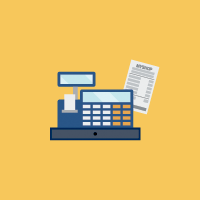
POINT OF SALE (POS)
POS means Point-of-Sale, of course, and it is about having a till terminal that can communicate with the ERP system.
The most important features
POS is a category of IT solutions that has come a long way technologically. It is no longer just about cash and payment cards; now it is about mobile payments, loyalty cards, coin vending machines, campaign management, discounts – the list goes on.
Many questions are important:
- Should we be able to take mobile payments?
- Do we need to handle cash, and should it be done without the cashier having access to cash?
- Do we need to register loyalty cards?
- How many customers pass through the till per hour, and how much time spent on manual handling is acceptable?
- How fast should item registration be?
- Do we need to handle items without barcodes?
- Do assistants need to be able to set prices and perhaps give discounts by themselves?
- Should the till be able to apply discounts from the ERP system for particular customers?
- Should each assistant log in to the till and all transactions in ERP be stamped with the cashier’s ID?
- Will the till have to withstand a particular environment, such as cold or moisture?
- Should the POS suggest upsells or complementary items?
- Should it be possible to see the inventory, perhaps also at other shops?
- Should it be possible to order items that are not on the shelf?
- Should the POS synchronize with the ERP solution overnight, or do we need orders to be registered immediately?
There are a great many questions to be resolved when choosing a POS solution. The above are just some of the most obvious.
Item Structure and Inventory Management
Item numbers and barcodes are a major topic in POS systems. If we sell items bought from vendors, we are somewhat at their mercy as far as barcodes are concerned.
Mapping item barcodes to the item numbers in the ERP system is an important preliminary to the introduction of a POS system.
We see cases where far too much is squeezed in on the same item number in the POS system because the retail shop works with one-unit price on lots of different items, meaning that the same barcode is used for different items.
This is bad news, because it makes inventory management impossible. You cannot see which items have gone through the till. You cannot measure wastage and theft. You cannot count the inventory.
The barcodes must also reflect the structure of variants that you work with in ERP.
If you sell a shirt in four different colors, six sizes and two materials, the POS registration must let you see in the ERP system exactly which variant has been sold. We will talk more about the topic of variants in the sections about ecommerce and master data.
You should also decide on the level of inventory management in store.
Companies typically want to manage the remote inventory in great detail, whereas inventory management in the individual shops is often less detailed.
Not many ERP systems offer a great solution for planning, replenishment and availability while also having a neat POS solution.

ECOMMERCE WEBSHOP
An online shop is something many companies need, whether they work business-to-business (B2B) or business-to-consumer (B2C) – or perhaps business-to-agent (B2A), or through another type of relationship.
There are many different ways of doing e-commerce, but we want to begin at the ERP system and work our way to the online shop.
Our journey begins in ERP
ERP systems are good at handling data. That is what they are designed for. E-commerce systems are not always optimal at handling data; it is often only the people working in the back-end system of the online shop who know about master data and data structures and understand how to maintain them.
We want to maintain as much data as possible in the ERP system. We are talking about structured data attributes, text strings for use in the online shop, images that need to be viewable or files that need to be downloadable. There is a lot of data involved.
It is a lot of work to maintain large volumes of item data in the e-commerce system. Updating data manually in both systems is definitely not a good solution.
Structured Master Data
The most basic data requirements are the master data on all items, all item descriptions, sale prices etc. As much of this as possible should be searchable, enabling the customer to search for products.
The information customers want to find in your web shop is of the same type as you want to have in the form of structured data in your ERP system. It makes sense to maintain the master data in ERP and synchronize it to the web shop.
Variants of master data
We have different variants of the same master data. Colours are a good example. We sell an item intended for children, and we stock it in six different colours: Cyan, Turquoise, Royal Blue, Magenta, Cherry and Pink.
These are not actually the colour codes used by our vendor, so our purchasing department has a field showing CMYK colours for all items.
On your online shop, customers may not search in such fine detail. They search for blue or red and is presented with the different variants.
In this instance, we end up with three different colour codes on each item. We need all this information on each item.
HTML-formatted text
The ERP system must also be able to store HTML-formatted text that will be sent to the online shop and displayed correctly.
We need to display icons and pictograms on items to show that the item is organic, paraben free etc. We must be able to register this in the ERP system so that the icons are displayed in the online shop.
We must also be able to store images of the item in the ERP system for display in the online shop.
The outside salesperson working in the ERP system can create sales orders on his tablet, and will benefit from having the same images, information and search options in the ERP system as customers have in the online shop. And warehouse workers will also be able to see the descriptions and all the images of the item to be picked.
Hierarchies
We also want to manage the hierarchies of items and item groups in the ERP system, i.e. the structure governing how items are found in the online shop when the customer selects a category or searches for items.
The goal is that we can create a new item and with master data in Business Central that automatically positions the item in the hierarchy, and then the item will automatically turn up in the right place in the online shop – images, prices and all – without anybody having to copy/paste anything to the online shop.
Integration
Actually, the hardest question when it comes to integration is how you want to utilize the features of the ERP system to provide good customer service in the online shop.
When a customer wishes to know whether an item is in stock, how does the online shop access the ERP system to find out?
We don’t really want integrations. We prefer that the online shop is managed directly from Business Central. And today, that is possible.


CRM & MARKETING
ERP & CRM
Generally, ERP systems integrate rather poorly with CRM (Customer Relationship Management) systems, considering how valuable that integration can actually be.
Broadly speaking, in the CRM system the job ends with an order, and in ERP everything begins with a quote or an order. However, there are a great many overlaps.
The salesperson making a deal with the customer wants to have access in the CRM to all the information and business rules in the ERP system so that he can make the best deals possible.
The ERP system contains product data, classifications, discount rules, purchasing history, invoices, payment history, amounts outstanding, inventory, reservations, delivery times, capacities, etc.
Working in ERP or CRM?
The salesperson can of course also create quotes in ERP, and this may be the best solution, especially if items need to be configured.
But all the customer dialogue, emails and activities are normally managed in CRM, not in the ERP system, so by that argument it would be preferable to have the quote in the CRM system.
Integration
Integration between ERP and CRM is often simple and hand built. Integration between Business Central and Dynamics 365 Sales is improving gradually.
Fundamentally, we must be able to create an order in CRM and send it to ERP, and yet this is far from sufficient. CRM and ERP need to be two integrated business processes. Nor is transferring data from ERP to CRM sufficient to keep the salesperson informed.
What about error handling, for example, or changes? What should happen if an order is changed, either in ERP or in CRM? Should a change in the CRM show up in purchasing and production in ERP? Will a change of delivery date, say, in ERP also be visible in CRM, and can the salesperson see that he ought to speak to the customer about the new date?
We can come up with many examples of this sort, and the integration ends up turning into a major task.
The ultimate solution is for the salesperson to use ERP components made available by ERP to CRM and so beautifully integrated that the salesperson does not notice that some of the features actually come from a different system.
Ordinary two-way synchronization of master data such as contact details can thus be tackled by means of ordinary integration, and business logic can be dealt with by embedding features from the other system.
Marketing integration
When we talk about sales and marketing, we must not forget that the marketing department has a growing IT requirement.
In our experience, most current CRM systems are not designed for marketing people working in the early stages of the customer journey. The sales director is normally unaware of Marketing’s IT needs, while most modern marketing people see CRM only as a contact database.
It is far from unusual for the marketing department to subscribe to 10-20 different cloud systems that the IT department has never heard of. And some of them even integrate with CRM or ERP, without the CRM and ERP managers being aware of it.
Different tools for different stages
In general, we work in different stages on the customer journey:
- ERP registrations: from sales quote to purchase order.
ERP is about transactions and business rules. - CRM registrations: from lead to sales order.
Salespeople need communication possibilities and access to information to strengthen them in their dealings with the customer; they need help with keeping tabs on things and with prioritizing their day-to-day effort. - Marketing’s registration requirements: from first contact to lead.
CRM is not enough for Marketing, because CRM only gives full control if you look at each and every customer manually.
Marketing needs automated processes that emulate manual processing.
Marketing therefore purchases process tools such as marketing automation to monitor large amounts of data, profile customers and carry out automated processes on that basis.
CRM should of course be integrated with the marketing department’s tools. Sometimes, this can be done very easily. For example, Power Automate can take data from email systems or marketing campaigns and directly create leads or contacts in Dynamics 365 Sales.
The marketing department’s tools can be very helpful to the salespeople. They can gather a lot of customer behaviour information that will be of interest to the salespeople.




